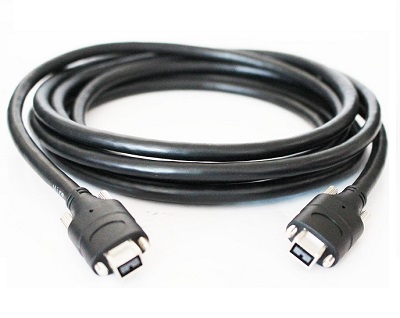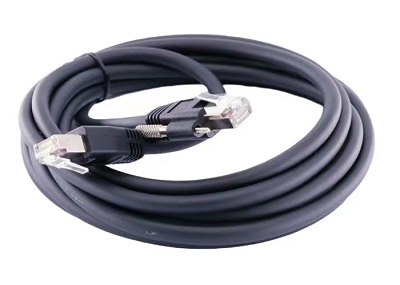An industrial camera is a key component of a machine vision system, the essential function is to convert an optical signal into an organized electrical signal. If you want to transmit the mages, need to use the camera’s interface to transfer the image data to devices. The industrial camera cable is specifically used for industrial cameras. With the development of industrial production inspection and special application monitoring, the requirements for speed and accuracy are increasing, and it should work in motion control and other harsh environments for the camera data and power transmission, so the demand for high-speed assembly line or large-format inspection scenes has given rise to different types of industrial cameras using different industrial cables, what are the common types of industrial camera cable interfaces?
USB interface
USB interface camera is a digital camera, output digital image signal. USB full name is Universal Serial Bus (Universal Serial Bus), USB interface is 4 pins, of which two for the power wire, two for the signal wires. USB is a serial interface, hot-pluggable, easy to connect. The early USB2.0 interface, almost computers are equipped with a USB interface, no capture card. However, the USB2.0 interface transmission rate is slow, with speed and 480Mbps, and communication distance of 5m, 80% of the bandwidth used for image transmission, the process requires CPU involvement in the management, occupying and consuming resources. Additionally, the USB2.0 interface generally does not have a fixed screw, the connection is not stable, which is a risk of loosening in the sports equipment. Later upgraded to USB3.0, USB3.0 on the basis of 2.0 added two sets of data wires, solved the problem of slow transmission speed, the speed has reached 4.8Gbps, but the transmission distance is still close, about 10m, 80% of the bandwidth for image transmission, due to the convenience of USB interface cameras, currently in the microscope, scientific research experiments, portable devices and other applications. USB TYPE Micro-B interface is still in the mainstream of industrial interface cameras, the future of USB interface cameras will begin to popularize the USB Type-C interface.

1394 interface
1394 interface, IEEE1394 bus is a high-speed serial bus, also called “FireWire” , which supports hot-plugging, real-time data transmission with a bus structure, plug-and-play. It is used to connect digital products to computers and other machines, and is widely used in industry with good protocols and encoding methods and stable transmission speed. 1394a maximum speed of 400Mbps and 1394b maximum speed of 800Mbps, which requires attention to its Packet Size setting. Packet Size is the bandwidth of the entire 1394 bus. IEEE 1394 interface, no controller, can achieve peer-to-peer transmission, 1394a maximum transmission distance of 4.5 meters, 1394b transmission distance is usually 10 meters, in the case of reduced data rate can be extended to 100 meters (100Mbps), the use of relay equipment support can further improve the transmission distance.

Camerlink interface
The digital image signal communication interface protocol introduced by AIA Association, which is a serial communication protocol. It uses LVDS interface standard , which has high speed, strong anti-interference and low power consumption. Developed from Channel link technology, adds some transmission control signals and defines transmission standards based on Channel link technology. The protocol adopts MDR-26 pin connector or SDR-26 pin connector, which has the high speed features, bandwidth up to 6400Mbps, strong anti-interference and low power consumption. However, due to its need for a separate CameraLink interface, not portable, leading to the high cost of Camera Link interface cameras, the actual application is rather low.

Gigabit Ethernet Interface
Gigabit Ethernet Interface, created and promoted by the AIA (Automatde Imaging Association), it is a camera interface standard developed based on the Gigabit Ethernet communication protocol. It’s suitable for industrial imaging applications, transmits uncompressed video signals through the network over long distances with affordable cables.
The Gigabit protocol is stable and easy to use, and it can work when connected to a Gigabit network card. Gigabit Ethernet protocol is stable, easy to use, connect to a Gigabit network card can work, set this parameter, you can achieve better results, Transmission distance is long, can transmit 100 meters. Multiple devices can be used at the same time with small CPU occupancy.

CoaXPress interface
CoaXPress is an asymmetric, high-speed point-to-point serial communications digital interface, transmission speeds up to 6.25Gbps and distances exceeding 100m.
Large volumes data transfer and long distances are available, with a choice of transmission distances and volumes: from 50m@6.25Gbps to 170m@1.25Gbps, low price, easy integration, and hot-plugging support. The CoaXPress standard can support the growing bandwidth over the next decade while meeting many additional requirements such as: larger cables, higher reliability and flexibility, and cost effective. The use of standard coaxial cables and bandwidths allows CoaXPress not only for machine vision applications, but also for medical and security markets where coaxial cables are widely used. By using the same coaxial cable, CoaXPress is able to upgrade from analog to digital video using IEC standard cables and connectors, The cameras and image capture cards are available with two types of connectors – 75Ω DIN 1.0/2.3 type or 75Ω BNC type, both of which are ideal for high vibration industrial environments.

Above are the common types of industrial camera cable interfaces, whose different types of industrial camera cables are suitable for different product application . Human society is entering the era of big data of visual information. Industrial cameras can be the soul of the industrial automation system, from object/barcode identification, product inspection, and appearance dimensional measurement to robot arm/transmission equipment positioning, where industrial camera technology can make sense.





